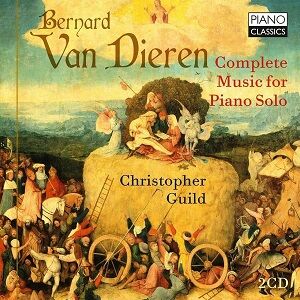
Bernard van Dieren (1887-1936)
Complete Music for Piano Solo
Six Sketches, Op 4a (1910-11)
Toccata (1912)
Theme and Variations (1927)
Three Studies (early 1920s)
Netherlands Melodies (1917)
Piccolo Pralinudettino Fridato (1934)
Ballad de Villon (van Dieren/Warlock ed. Christopher Guild) (1917)
Christopher Guild (piano)
rec. 2021, Old Granary Studio, near Beccles, Suffolk; Ledger Recital Room, Royal Conservatoire of Scotland, Glasgow
Text included
PIANO CLASSICS PCL10241 [54 + 47]
Bernard van Dieren had several strings to his bow. In addition to being a composer he was a critic, author, and writer on music. Although born in Rotterdam, he spent most of his working life in England. He moved there in 1909 with his future wife, concert pianist Frida Kindler (1879-1964). They married the following year and had one son. He took a job as London music correspondent for a Rotterdam newspaper. When he started to compose he came to the attention of such distinguished names as Jacob Epstein, Cecil Gray and Philip Heseltine who, together with Busoni and Schoenberg, offered encouragement and support. From 1912, a kidney problem began to afflict him, and recurring renal stones required morphine on occasion. By 1936 his health had broken down completely and he died prematurely on 24 April that year at the age of only forty-eight.
What attracted me to this release and a desire to review it follows a previous encounter with the composer’s music I had in 2017 when I had the great pleasure of reviewing a recording of his orchestral works, including the Symphony No.1, Op.6 Chinese, issued by the Lyrita label. What a terrific disc; it certainly won me over. So, I sought out a copy of The Bernard van Dieren Collection (British Music Label BML001), enthusiastically reviewed by my colleague Rob Barnett. I soon realized, however, that the composer hasn’t been wholeheartedly embraced by the record companies, and is certainly not generously represented on CD. That makes this recent release of the composer’s complete piano music all the more welcome.
The piano music spans a period of twenty-four years from the Six Sketches, Op 4a (1910-11) to Piccolo Pralinudettino Fridato, van Dieren’s last piano work, written just two years before his death. The music brims over with self confidence. It’s technically challenging for the pianist, yet highly sophisticated and compositionally advanced. It can certainly hold its own against the compositions of Schoenberg and Busoni. Its complexity makes no concessions to popular taste.
The earliest composition here are the Six Sketches, Op 4a. Penned in 1910 and 1911, they weren’t published until 1921. Some consider them the pinnacle of van Dieren’s solo piano oeuvre. The Sketches are certainly challenging to the listener, being atonal, dissonant and intensely chromatic and they were as ground breaking as any other works at the time. There’s much contrast between them. Take Nos. 3 and 4 for instance. The former is swirling and lyrical, radiating an impressionistic glow, whereas the latter is angular and acerbic.
The following year the composer wrote his Toccata. The notes suggest that the title is a misnomer as this is no Toccata in the traditional sense. It’s certainly “no vehicle for virtuoso display”. To me it sounds very improvisatory and meandering. One gets the feeling that van Dieren was in pondering mode, exploring different landscapes.
Fast forward fifteen years and we have the Theme and Variations. The Theme and Fourteen Variations are cast in a much more approachable style. All are brief, apart from three, lasting below a minute. They were premiered by van Dieren’s wife Frida at the Wigmore Hall in 1927. They are exuberantly agile and cover a wide range of moods, emotions and styles – spiky, brusque, pondering, wistful and gently lyrical.
The Three Studies from the early 20s are laden with chromatic harmonies. The first is my favorite. It’s as if the composer is contemplating fond distant memories with wistful reflections. The second seems to savour the moment, whilst the third is more fractious and serrated.
We escape tortuous chromaticism and enter a world of genteel simplicity in the Netherlands Melodies. They are a collection of twelve settings of tunes van Dieren heard as a boy in Rotterdam. Some are carols and hymns, others children’s songs – that should give you some idea of their pitch.
The composer wrote his short piece Piccolo Pralinudettino Fridato for his wife to celebrate her birthday in 1934. It was to be his last piano work. It’s unknown whether Frida ever performed it in public. Guild uses an edition of Ronald Stevenson (Bardic Edition).
The Ballade of Villon, the final work on the disc, is receiving its recording premiere. In 1917, van Dieren set a poem by François Villon for reciter and string quartet. Philip Hesletine later arranged the string quartet part for solo piano. It’s quite a meditative piece, surrounded by an aura of calm and tranquility. It’s given a radiant performance by Christopher Guild, with Dr James Reid-Baxter as reciter. The text of the poem is included in the booklet in French only.
Christopher Guild’s championing of rare piano music by lesser-known composers is to be lauded. He’s a strong and responsive advocate for this music. I see from his website that he’s recorded piano music by Ronald Stevenson, Francis George Scott and Ronald Center. The sound quality of this van Dieren release really distinguishes this recording. The two venues offer the ideal acoustic and ambience to showcase these intriguing works. Alastair Chisholm’s liner contribution provides appreciative context. I must commend the vibrant Hieronymus Bosch artwork. I would urge all who are willing to push the boat out a little not to hesitate.
Stephen Greenbank
Help us financially by purchasing from



Previous reviews: Jonathan Woolf (September 2022) ~ John France (October 2022)


















